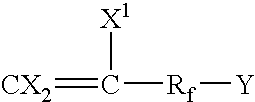Process for producing fluoropolymer
- Summary
- Abstract
- Description
- Claims
- Application Information
AI Technical Summary
Benefits of technology
Problems solved by technology
Method used
Image
Examples
reference example 1
(Preparation of Seed Polymer Particles)
[0172] A 1.8 liter polymerization vessel equipped with an electromagnetic induction type stirring device as the stirring device was charged with 720 g of deionized water, 290 g of a 10% by weight aqueous solution of ammonium perfluorooctanate and 0.6 g of diethyl malonate. After the system was sufficiently replaced with nitrogen gas, the pressure was reduced. This procedure was repeated 3 times. 20 g of VdF and 51 g of HFP were added under reduced pressure and the temperature was raised to 80° C. while stirring. Subsequently, 0.02 g of ammonium persulfate (APS) dissolved in 0.6 g of deionized water was injected by nitrogen gas to start polymerization. The polymerization pressure was set to 2 MPa and in order to compensate for the pressure decrease during polymerization, a monomer mixture of VdF / HFP (78 / 22 (% by mol)) was supplied successively and polymerization was conducted while stirring. After 30 minutes, stirring was stopped and the monom...
reference example 2
(Preparation of Seed Polymer Particles)
[0173] A 1.8 liter polymerization vessel equipped with an electromagnetic induction type stirring device as the stirring device was charged with 809 g of deionized water, 200 g of a 10% by weight aqueous solution of ammonium perfluorooctanate and 0.6 g of diethyl malonate. After the system was sufficiently replaced with nitrogen gas, the pressure was reduced. This procedure was repeated 3 times. 0.5 mL of isopentane was added under reduced pressure and each of the monomers were added so that the composition inside the vessel at 80° C. became VdF / TFE / HFP=29.0 / 13.0 / 58.0% by mol and the pressure inside the vessel became 1.4 MPa. After the temperature was increased, 0.67 g of ammonium persulfate (APS) dissolved in 20 g of deionized water was injected by nitrogen gas to start polymerization. The polymerization pressure was set to 1.4 MPa and in order to compensate for the pressure decrease during polymerization, a monomer mixture of VdF / TFE / HFP (5...
example 1
(Preparation of Fluorine-Containing Polymer)
[0175] A 1.8 liter polymerization vessel equipped with the same stirring device as in Reference Example 1 was charged with 1258 g of deionized water, 26.65 g of an aqueous, dispersion of the seed polymer particles prepared in Reference Example 1 (16.3% by weight concentration) and 4.91 g of diethyl malonate. After the system was sufficiently replaced with nitrogen gas, the pressure was reduced. This procedure was repeated 3 times. 76 g of VdF and 323 g of HFP were added under reduced pressure and the temperature was raised to 80° C. while stirring. Subsequently, 0.195 g of APS dissolved in 20 g of deionized water was injected by nitrogen gas to start polymerization and polymerization was continued under the following conditions (a) to (c). After 3 hours, stirring was stopped and the monomers were discharged to stop polymerization.
[0176] The composition ratio (mol) of the gaseous phase monomers VdF / HFP was 36 / 64 before polymerization and...
PUM
| Property | Measurement | Unit |
|---|---|---|
| Temperature | aaaaa | aaaaa |
| Fraction | aaaaa | aaaaa |
| Fraction | aaaaa | aaaaa |
Abstract
Description
Claims
Application Information
 Login to View More
Login to View More - R&D
- Intellectual Property
- Life Sciences
- Materials
- Tech Scout
- Unparalleled Data Quality
- Higher Quality Content
- 60% Fewer Hallucinations
Browse by: Latest US Patents, China's latest patents, Technical Efficacy Thesaurus, Application Domain, Technology Topic, Popular Technical Reports.
© 2025 PatSnap. All rights reserved.Legal|Privacy policy|Modern Slavery Act Transparency Statement|Sitemap|About US| Contact US: help@patsnap.com



